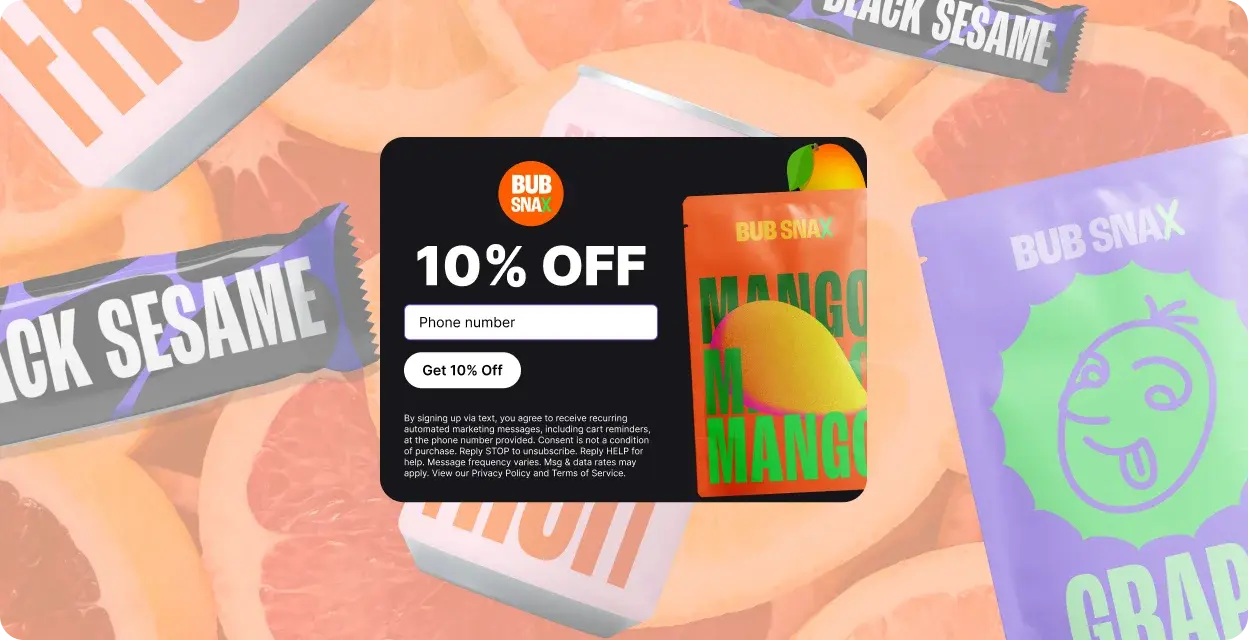
Access premium content. Become an SMS expert.
Join over 10,000 other marketers who get weekly insights delivered directly to their inbox.
We are big fans of privacy. See our Privacy Policy for more information.
SMS List Building and Data Segmentation
How to Increase Subscribers while Decreasing Spend
We’ve all heard the saying: If a tree falls in a forest, does it make a sound?
Now imagine your ideal marketing campaign: You’ve perfected your customer persona, created eye-catching graphics, and set aside a part of your budget to use. You know it’s a slam-dunk, but what happens if no one sees it?
When it comes to new marketing techniques, like SMS, many brands tend to “test the waters” before going all-in on their campaigns. Yet results from small tests that use small groups of subscribers are often not indicative of what you’d see from a campaign sent to a larger group of subscribers.
Many brands new to SMS spend a lot of time focused on the content of a message, like what GIFs and emojis to use or what copy to write. The truth is, their primary focus should be on growing the number of people who are subscribed to their SMS list.
List growth, when done effectively, organically increases the number of people who see your marketing campaigns, which directly correlates to the chances of your campaign producing good ROI.
Once your list is large enough, you can start segmenting your subscribers. This allows you to send tailored messages to different subscriber groups with different buying habits. This helps decrease your spending while increasing customer engagement.
List growth and segmentation require effort upfront, yet the massive ROI you’ll see is worth it. They also let you flex your creative muscles and learn more about your customers. We’ve compiled some fantastic examples, best practices, and other tips to help you grow your list, segment your customers, and master mobile marketing. We’ll let you in on a secret: both are easy to do in Postscript.
SMS List Building Basics
SMS marketing is a mix of two things:
Effective list growth, and
Effective personalization that nurtures users along the customer journey.
So how do you get people to join your SMS subscriber list? Subscribers can join by entering their phone number in a compliant popup or form, texting a specific keyword to your short code or long code number, or during Shopify checkout. We call this “opting-in.”
The key to each of these opt-in actions is ensuring that the proper TCPA-compliant language is present.

TCPA-compliant language makes sure that the user entering their phone number or texting a keyword to your short code is aware that doing so opts them into receiving SMS marketing messages from your shop.
Shops found to be non-compliant, regardless of the platform they are using, face fines of $500-$1,500 per text message and continued offenses can result in having a short code or long code banned.
You can learn more about TCPA-compliance (and the ways Postscript keeps our merchants compliant) here.
Now that we’ve talked about compliance, let’s look at some creative ways to get your subscribers to opt-in to SMS messages.
11 Opt-in methods to build your text message subscriber list
Every ecommerce store has a different user experience. Maybe your shoppers come through organic search, or maybe an influencer mentioned you in a viral TikTok. Maybe you’re involved in a few active Facebook groups, or maybe you see huge returns on ad spend via social media advertising. These just scratch the surface. The reality is there’s a lot of different journeys a customer could take that end with them purchasing a product.
You’ve likely learned your customers’ journey through user research, surveying, and testing. If you haven’t, we recommend you hit pause on adding a new communication channel until you have a better idea of your customers’ purchasing journey.
Once you have your customer journey mapped out, then you can start collecting SMS subscribers.
1. Desktop and Mobile Website Popups
Desktop and mobile website popups are the most common and effective form of SMS collection. Popups encourage subscribers and new customers to submit their contact information, often in exchange for an incentive, like a discount or promotional offer.
Popups are an ideal SMS list-building tool because they’re also highly customizable. It’s easy for you to make the entire popup experience eye-catching and entertaining using your brand voice, colors, fonts, and images. You can even customize your desktop and mobile popups to collect a subscriber’s phone number, email address, or both, depending on your team’s preference.
Offer an incentive in exchange for a phone number. Popups can yield high conversion rates if your offer is compelling. Try out a discount, promotion (e.g., free shipping, free product, etc.), or entry into your VIP or “First Look” club.
Showcase your brand. You can customize popups to reflect your brand voice and image. Use preferred fonts, colors, and images of your products. Popups featuring strong imagery convert 83% better than those without an image.
Get creative with the interaction. Opt for a traditional overlay popup or take advantage of popup platforms like Junstuno or Wisepops that offer interactive popups, like quizzes or “spin to win” experiences.

Harper Wilde offers two incentives with their popup: a discount and early access to product drops. They customize the look and feel with product imagery, font, and buttons that reflect their brand. Most importantly, their popup is TCPA-compliant.
Learn more about growing your list with popups and Postscript here.
2. Opt-in Landing Pages and Banners
Landing pages aren’t just the first page a visitor sees when they check out your website. You can create hidden landing pages with an embedded opt-in form that you can link in social media posts, email advertisements, and other promotional materials.
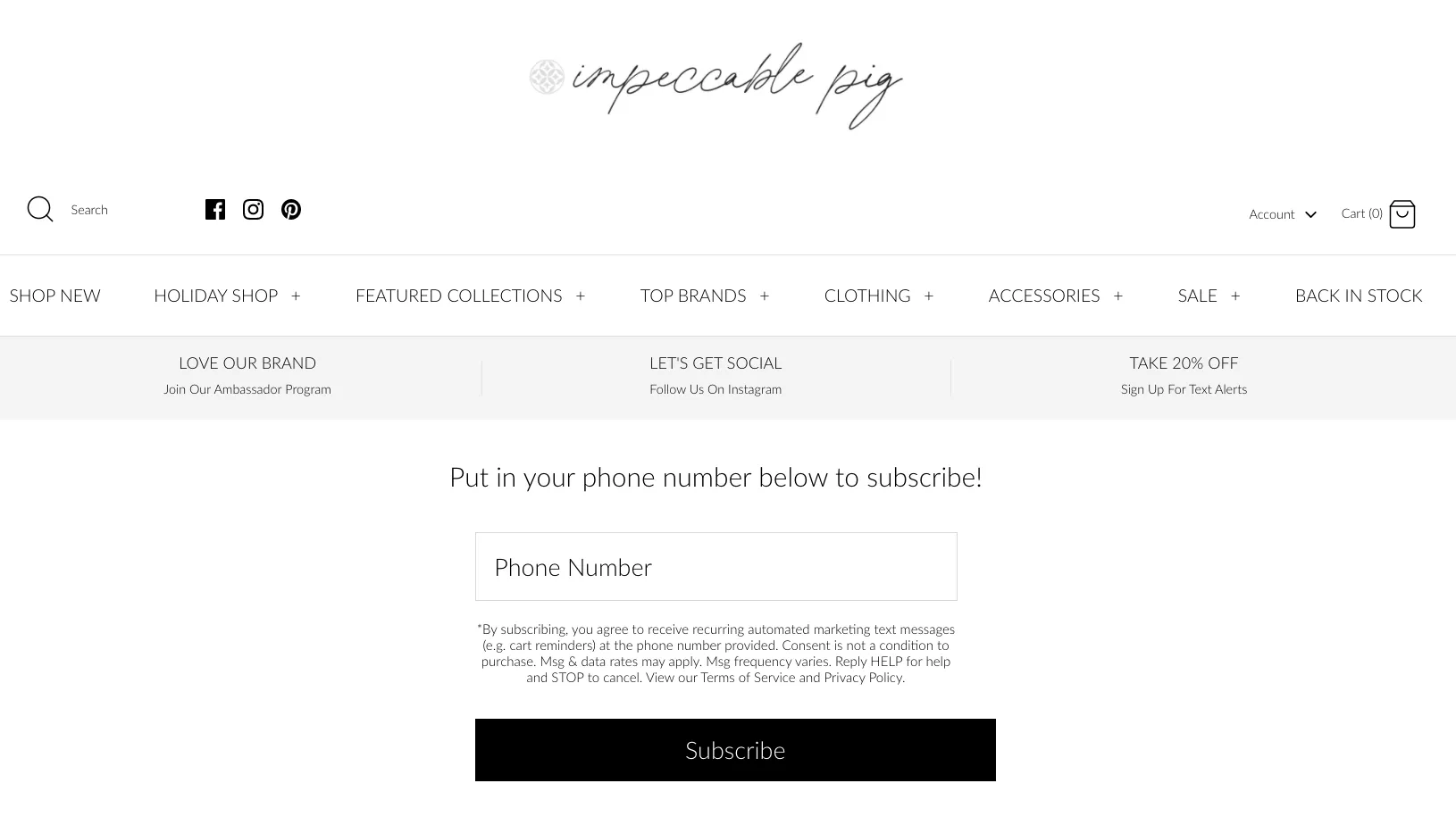
The team at The Impeccable Pig have a sticky menu with three calls to action: join the ambassador program, follow on instagram, and signup for text alerts. The text alert button takes you to the landing page shown above that features a compliant opt-in form where subscribers can enter their phone number in exchange for 20% off their order. The team can link this page on any of their marketing materials with complete confidence that they’re growing their SMS list in a compliant way.

Website banners are an easy way to stay ever-present to your website visitors. It's a great alternative to popups and an easy way to stay available to visitors who exited out of the popup without opting in.
DRMTLGY has seen incredible success by keeping their SMS opt-in opportunity ever-present in a banner on their website. Nearly 68,000 people have opted in with the keyword assigned to their opt-in form.
Learn more about growing your SMS list with a dedicated landing page here.
3. Convert Your Email List
List building might be familiar to you. Many brands starting out with SMS have previously dedicated significant time and effort to build a list of email subscribers. Those subscribers are individuals already interested and/or invested in your brand and products, making them ideal SMS subscribers.
Consider sending a dedicated email that features your SMS opt-in. For a call to action, include a button that links to a TCPA-compliant opt-in form or displays a keyword and your phone number.

The team over at Dr. Squatch were so excited about the launch of their Star Wars collection that they wanted to give their SMS subscribers first dibs. By sending out a dedicated email blast, they gave their email subscribers a chance to opt-in to this exciting opportunity.
To make their pitch a little more subtle, Snif included their SMS section toward the end of their usual marketing email and included the information subscribers need to know: the keyword and the phone number to text.

Want an extra level of engagement? Consider incentivizing signups with a percentage off, or a giveaway like what Power Digital Marketing did for Helm Boots.
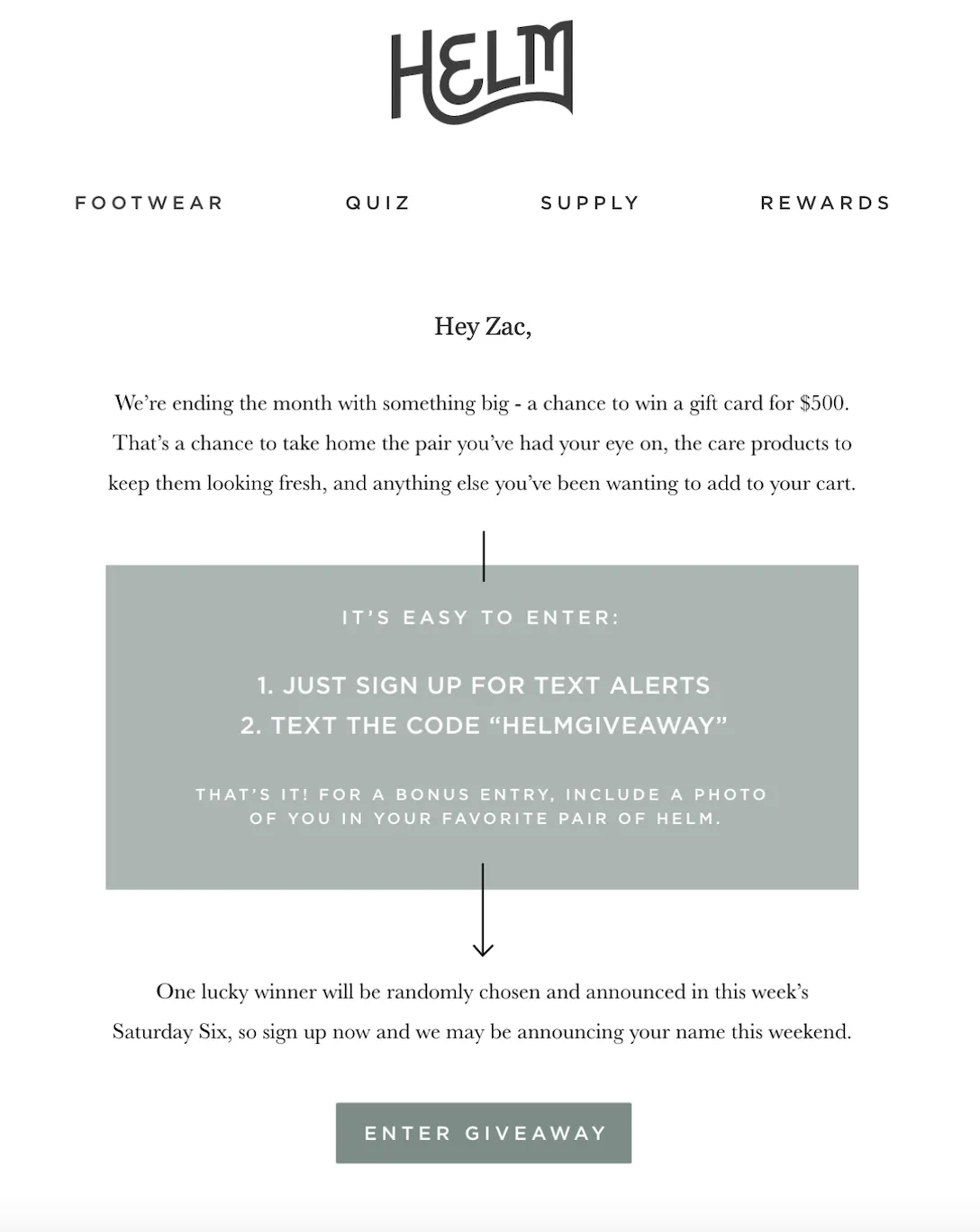
Learn more about growing your SMS list with email and Postscript here.
4. Product Drops
The ecommerce “Drop Economy” packs a one-two punch: it builds hype and scarcity for products while also giving merchants insight into future demand. Lean into the hype and use SMS as a “first to know” communication tool. Encourage users to opt-in to SMS if they want to be the first to know when new products drop.
Beauty and skin brand, Kopari, teases product drops in their newsletters and social feeds. This clip from a newsletter takes subscribers to a dedicated landing page where they can enter their phone number to stay up-to-date on product drops.

Learn more about growing your SMS list with a dedicated landing page here.
5. Instagram
These days, consumers are more likely to check out your social media accounts before heading to your website to shop. Shoppers (83%) use Instagram to discover new products and services. That’s easy traffic you could convert into SMS subscribers.
There are a few ways to incorporate SMS list growth in your Instagram presence. While some capabilities are limited to brands with 10,000+ followers, there are options for everyone.
Instagram Stories
You can go one of two routes with Instagram stories depending on the number of followers you have.
For brands with 10,000+ followers, Instagram offers a link sticker that you can place anywhere in any story. These stickers replace Instagram’s swipe-up story.
Voltaire Cycles invited followers to join their text club using the Instagram sticker link and an animated button to draw attention to the link. Best part: their story includes TCPA-compliant language below the call to action.

Whimsy + Wellness has over 100,000 followers on Instagram and makes their SMS opt-in story part of their “Start Here” highlight. That means every follower and every visitor has the opportunity to learn more about the brand and join the SMS list to stay up-to-date on the latest Whimsy + Wellness news.
Instagram Pro Tip:
Link your story to a dedicated landing page and keep the opt-in experience consistent (and compliant) for both desktop and mobile subscribers. Check out how Whimsy + Wellness does it below:
If you don’t have 10,000+ followers, don’t fret—you can still advertise your keyword and phone number in an Instagram story. Just remember that you also need to include compliance language so subscribers know what to expect when they text in that keyword.
Instagram Grid Posts
Posting on your Instagram grid is a great way to stay present in your followers' Instagram feeds. You can promote a giveaway, sale, or VIP club and invite your followers to subscribe to SMS messages for a giveaway entry, discount code, or exclusive news and deals.
If you include a keyword and your phone number in a post, make sure you also include compliant opt-in language (the same goes with the description).
Olipop uses their Instagram feed to post SMS-related content. For example, when they launched SMS, they posted on their feed so their followers could join. More recently, Olipop promoted SMS as the way followers can learn about their new flavor drops.

Image source: Olipop Instagram
Influencers
Influencers can also help you grow your SMS list. Give each influencer their own unique keyword to share along with your phone number, then track the performance of each keyword within your SMS platform.

Instagram Bio
Last but not least, another quick and easy idea: put an opt-in link in your bio. We recommend linking to your dedicated landing page, where compliance language is part of the experience for both desktop and mobile users.
You can also use a “Link in Bio” solution such as LinkTree or LinkInBio. It’s a great chance to get important information in front of followers, but also lets you promote and link to your SMS landing page.

Learn more about growing your SMS list with Instagram here.
6. Facebook.
When it comes to social media advertising for retail brands, a lot of minds immediately turn to Instagram — and rightfully so. Instagram has more than 1 billion global users as of the end of 2020, so it’s a good place to begin your social media marketing strategy.
But some brands have found their niche in Facebook. It all depends on your target audience and where they hang out.
Bad Habit Boutique found their niche on Facebook, allowing them to reach their ideal customer demographic using product imagery and exciting SMS calls to action.

Image source: Bad Habit Boutique
Last but not least, there’s Facebook Messenger. Kizik used the Postscript and Recart integration to capture SMS subscribers who chat in.

Image source: Kizik Facebook
Learn more about growing your SMS list with Facebook here.
7. Packaging and Packaging Inserts
Curb appeal is real. Well-designed packaging influences customers’ purchasing decisions. Adding a keyword and phone number to your packaging lets customers know how to reach you via text. Opting for a QR code when the packaging surface is limited makes SMS opt-in a breeze.
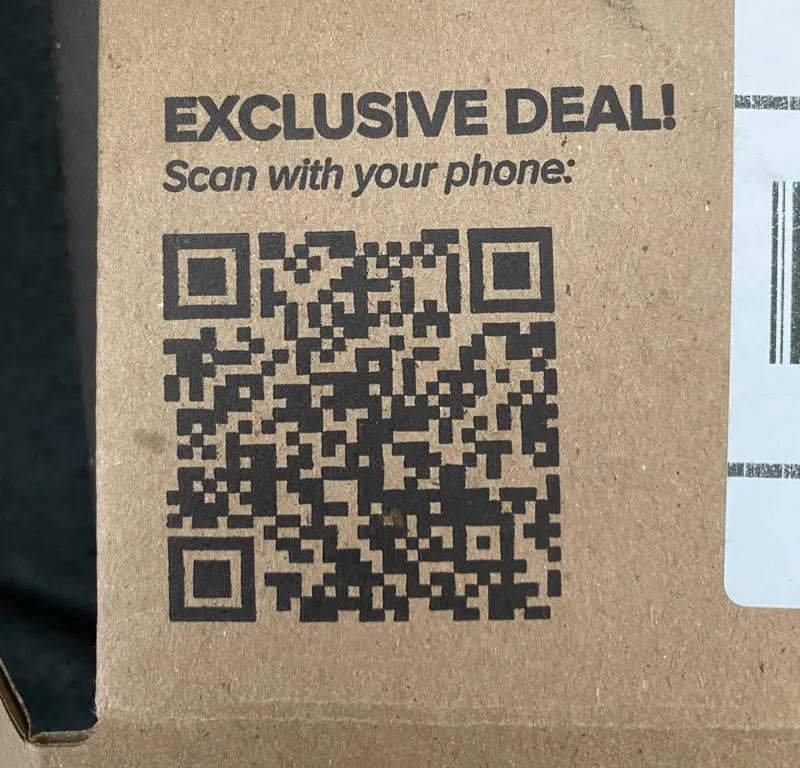
The team at DRMTGLY uses a QR code on the outside of their boxes to link customers to a compliant opt-in form where they can enter their phone number. Try it out! Point your phone camera at the above image and visit the opt-in page yourself.
You can also include QR codes and keywords in the unboxing experience. Create captivating packaging inserts that include opt-in instructions and capture potential subscribers who somehow missed other opt-in opportunities (or those receiving your product as a gift).

Fat Snax created packaging inserts for marketplaces they sold through, like Amazon. Having these inserts included with fulfillment orders allowed them to reach subscribers who’d completely missed out on their website and other marketing efforts.
The team at YumEarth took a two-step approach: they included a keyword call to action and a QR code. Both approaches are compliant because the team included the TCPA-compliant language beneath the call to action.
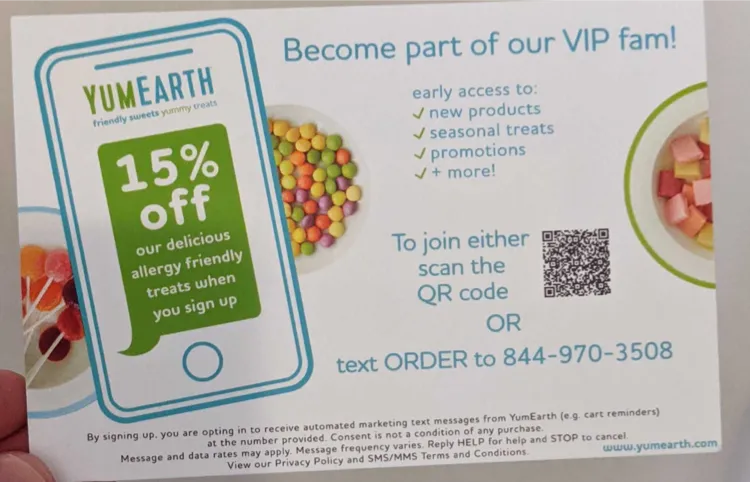
Learn more about growing your SMS list with QR codes here.
8. Print Advertising
While many digital marketers may say that print media is past its heyday, the truth is some retailers—household and CPG brands, especially—see success with editorial advertising.
As a bonus, SMS marketing adds an extra layer of conversion tracking to print advertising. Traditionally it was hard to track the ROI of a print ad because there wasn’t a pixel involved; however, using a dedicated keyword or QR code solely for print ads can give retailers a direct line into the traffic it brings.
9. Podcasts
Podcasts are all the rage these days, and many ecommerce brands have begun heavily investing in podcast sponsorships. It makes sense when you consider podcasts boast dedicated fan bases that value the opinions and recommendations of their show hosts.
With podcasts, you want a call to action that’s easy for people to remember and do on their phones (the device most commonly used to listen to podcasts).
Instead of directing them to a webpage, have listeners text a simple keyword to your shortcode. You can create a show-specific keyword (like you would for an Instagram influencer) and script that provides a clear call to action and compliance opt-in language, but still allows the hosts to make it fun and engaging.
10. Television
Now we’re getting to the super creative part. If TV watchers are in your company’s ideal customer profile, why not advertise your phone number as part of your next commercial? As a bonus, it’ll be even easier to track the conversion rate if you use a specific keyword.
11. Billboards
Why not? If you’ve seen success using billboard advertising, go for it. Just keep the keyword and shortcode brief. You don’t want to distract drivers.

SMS campaign segmentation basics
Soaring above 1,000 SMS subscribers is a great accomplishment, but the results (like click-through rate, open rates, and earnings per message) of the campaigns you send to these subscribers will hinge upon how well you can match their interests, desires, and place in the purchase journey.
That’s where segmentation comes in.
What is segmentation?
Segmentation is a best practice recommended across all aspects of marketing because it helps brands tailor their marketing messages to their customers’ attributes and behavior. With SMS segmentation, you target subscribers and customers based on collected data, such as order history or source of opt-in.
Say your store sells coffee and tea. Sending one campaign to all subscribers might result in some sales, but what if you could get a little more granular? What if you could separate your one list into two—coffee drinkers and tea drinkers? You could change up the messaging of each campaign and see better results.
How should you segment your SMS customer list?
How you segment your SMS subscriber list will depend on the platform you use to manage your SMS subscribers and campaigns. That’s assuming your SMS platform can segment customers. Not all allow you to get that granular, but Postscript does.
Here are some popular segment examples:
Geography or Time Zone:
Reach subscribers at their ideal time. For example, if a coffee brand is sending subscribers a message about their must-have morning cup, then the message should reach them in the morning.
With Postscript, you can segment for geography by selecting the Customer City or Customer State segment filters and entering your desired location.
Here we’ve created a segment for our California subscribers:

Customer Purchase Behavior
Repeat customers should receive different messages than first-time shoppers. Similarly, big spenders should receive different messages than budget shoppers. Segments can help you differentiate between these groups so you can customize the messaging.
The minute a subscriber interacts with your text, you can segment them even further with filters like Automations Clicked, Automations Received, Campaigns Clicked, Campaigns Received, Keyword Triggered, and more.
Here we’ve created a segment that includes all users who have texted the keyword ENDOFSUMMER2021 to our short code:

Customer Engagement Behavior
Re-engage subscribers who have seldom or never clicked a link in your SMS messages or who have never placed an order with your shop.
With Postscript, target various engagement levels using segment filters like Number of Orders, Subscriber Has Clicked, Last Order Date, and more.
Here we’ve created a segment of subscribers who’ve yet to purchase from our shop. We can reach out and perhaps offer a discount to convert them to a customer:

A/B Testing
Segments are a must-have for A/B testing. If you want to send different groups of customers different messages to understand which message performs better, you’ll need to first create segments.

By viewing subscriber engagement on your test campaigns, you can learn what type of messages your subscribers interact with: Do they like GIFs or emojis? Do they interact more with messages that contain a discount versus a free shipping offer? Testing out different approaches allows you to make informed decisions based on learnings from your actual target audience.
How to Automate SMS List Building and Database Segmentation for Ecommerce with Postscript
At Postscript, we understand the importance of a perfectly tailored message. The more specific you create your segment, the easier it is to craft a message that makes a subscriber feel as though you’re speaking directly to them. That level of rapport can do wonders for your flight-through rates and conversions.
That’s why Postscript makes segment creation easy. Brands can choose from 35+ filters when building a segment and can add multiple criteria points.
Postscript’s deep integration with Shopify also allows brands to segment their subscribers using any segment they set up in Shopify. This includes customer tags, which can designate any attribute or behavior you’d like.
Learn more about how to create segments with our step-by-step instructions below.

Name your segment. Choose a name that tells you who the segment targets.
Define your criteria. Choose your criteria and a refinement filter (e.g. greater than, includes, etc.). Enter your value in the empty field.
Add additional criteria. You can include one or more criteria in a segment. Additional criteria help you further narrow your intended subset of customers. You can add additional criteria using AND or OR statements
AND Example: Customers who have spent over $50.00 AND have never received a text from our store.
OR Example: Customers who have purchased our coral water bottle OR customers who have purchased our lime green water bottle.
Review segment size. As you apply criteria, the number of members in your segment size will adjust. If the number doesn't look correct, double-check your criteria.
Save. Now you’re ready to send a customized campaign to this segment of subscribers!
Conclusion
If you’ve made it this far, congrats! You’re now well equipped with tons of ideas for list growth and a clear understanding of how to segment your list to maximize your ROI from SMS. Remember to start by building your list, and then refine it into segments as you go. And above all, make sure everything you do is compliant.


